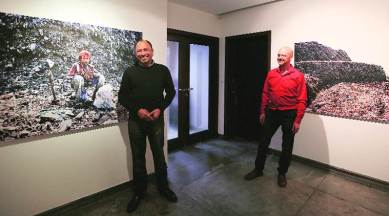📣 For more lifestyle news, click here to join our WhatsApp Channel and also follow us on Instagram
On Unfamiliar Terms
A collaboration between French artist François Daireaux and Delhi-based Ravi Agarwal results in an exhibition where viewers return with a sense of gain and loss

Till a decade back, French artist François Daireaux was not even familiar with the existence of the city of Firozabad, 250-odd km from Delhi and more than 6,000 km from his hometown Paris. It was bangles from the district in western Uttar Pradesh that first led Daireaux to discover it on the map. In 2011, he planned his first trip to the city. Since then, there have been innumerable others. “I wanted to see the process of how these bangles were made. A lot of my work revolves around the condition of workers and their concerns,” says Daireaux.
At the exhibition “The Familiar is Always a Stranger” at Gallery Espace in Delhi, he is showing a video from Firozabad that dwells not on its glass manufacturing industry but the political and socio-economic fabric of India. Titled Bhagwati, the 74-minute video has clippings from the office of Devki, owner of Bhagwati Glass Enterprises, a glass tube factory in Firozabad. He monitors his staff distantly from his office, where he has a screen that feeds from six surveillance cameras in the factory.
monthly limit of free stories.
with an Express account.
The video shows scenes from the screen as well as Devki’s conversations with associates and friends on business, politics and the economy, the deep relationship shared between each, and how the lives of numerous workers are affected by the more distant events. “In this age of globalisation, everything is so deeply interconnected that it is difficult to see things in isolation,” says Daireaux.
In his first exhibition in India, he is showcasing his work alongside another artist who has consistently attempted to project the complexities that inhabit the country— activist-artist Ravi Agarwal. “We felt the way we see landscapes in a broader sense was similar,” says Agarwal, as he recalls the origins of this joint presentation. It was a chance visit to Agarwal’s solo “Else, All will be Still,” in Delhi in April 2016 that drew Daireaux to the former’s work and the two decided to exhibit together. The current display is a testament to their shared concerns. We are welcomed by a photograph of a boy with his underpants stuffed with objects, standing on the banks of the Yamuna river. Daireaux names him “The Bather”, and places an empty tub in concrete before his photograph.
His protagonist seems to be on a constant lookout, just as Agarwal’s Boy in Blue Striped Shirt, a waste picker in Delhi whom Agarwal has befriended in the last couple of months. “I have always been interested in the marginal and how power plays out in society,” says the Delhi-based artist, who also heads the NGO Toxics Link. He emphasises how waste, too, has an afterlife. His work Memorabilia, a series of nine photographic prints, is focused on objects collected by landfill workers — a bunch of keys, a bracelet and beads, among others. In another set of prints, Gesture, Agarwal photographs the details, juxtaposing hands of workers sieving garbage with an Ambedkar statue pointing towards the sky, referring to the complex caste equations.
Pondering over these multiple arguments, as viewers head to the gallery basement, they are introduced to Augustin. Dressed in red shots, Daireaux tells us he has been rummaging the Yamuna riverbed for several decades, to clean it, and also to find objects that he can sell. Daireaux bought some of these objects from him — finger ring, broken idols, currency coins and rosary beads among others — and mixed them in black rubber in the work Augustin, Seven Days, dedicated to the Delhi resident. Accompanying the installation is an inkjet print on the wall, The Bridge, denoting the numerous walls across the country that wear religious symbols, apart from Augustin’s religious background. “He was a Hindu from Maharashtra, converted at the age of eight when he was studying in a catholic school,” says Daireaux.
If old gives way to new in Agarwal’s video Lb/in 2, where he puts together recordings from two factories, in Suite, Daireaux “captures and composes 176 sequences depicting gestures/actions of manual workers”. He has been filming them since 2004, and featured in the video are workers from across the world — Algeria, China, Morocco, Uzbekistan, Pakistan and India, among others — engaged in manual tasks; giving a neck massage, checking bulbs before they go to the market or even making cotton candies on a kiosk. “I am adding new gestures.
The realities are constantly changing,” says Daireaux.
At Mudac in Switzerland, at his exhibition, “Blow Firozabad Bangles”, he has brought together the glassmaking tradition of the two cities of Firozabad and Meisenthal. “We cannot compare Firozabad to Meisenthal but both cities have a similar heritage within a different context and at another human scale,” says the French artist.
In the Capital, visitors to the exhibition return with a sense of loss and gain. They are familiarised with aspects of their surroundings that they were probably oblivious to but, at the same time, realise lost traditions and fast-changing realities of the present day.
📣 For more lifestyle news, click here to join our WhatsApp Channel and also follow us on Instagram